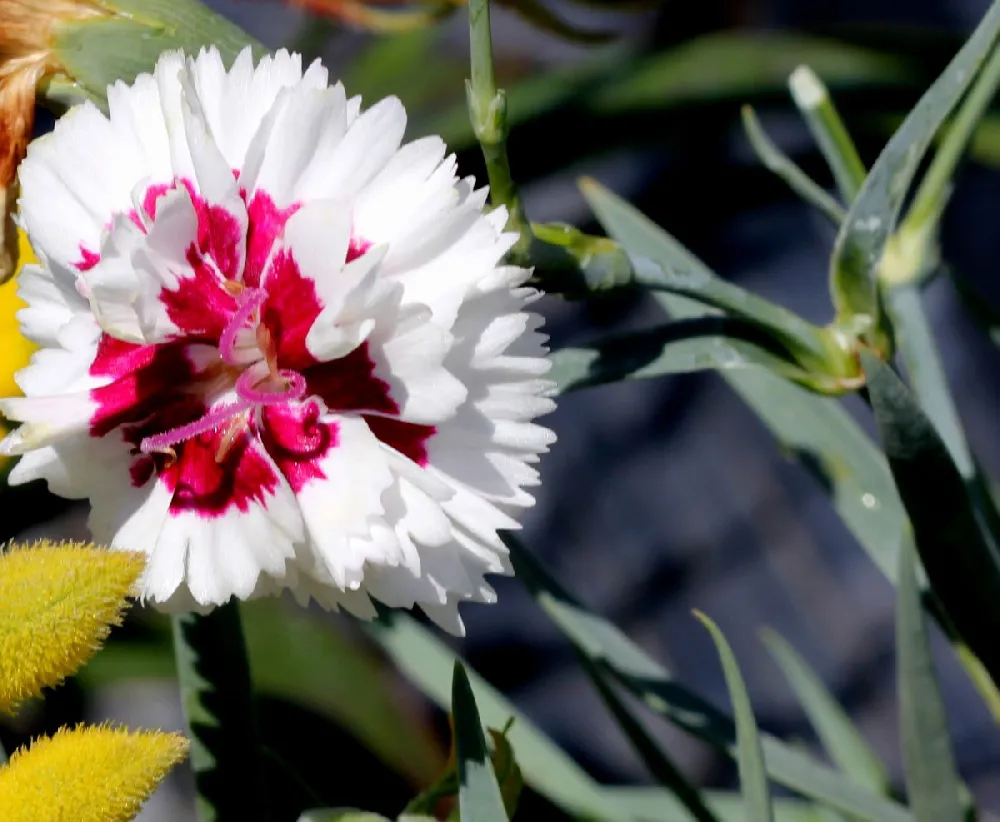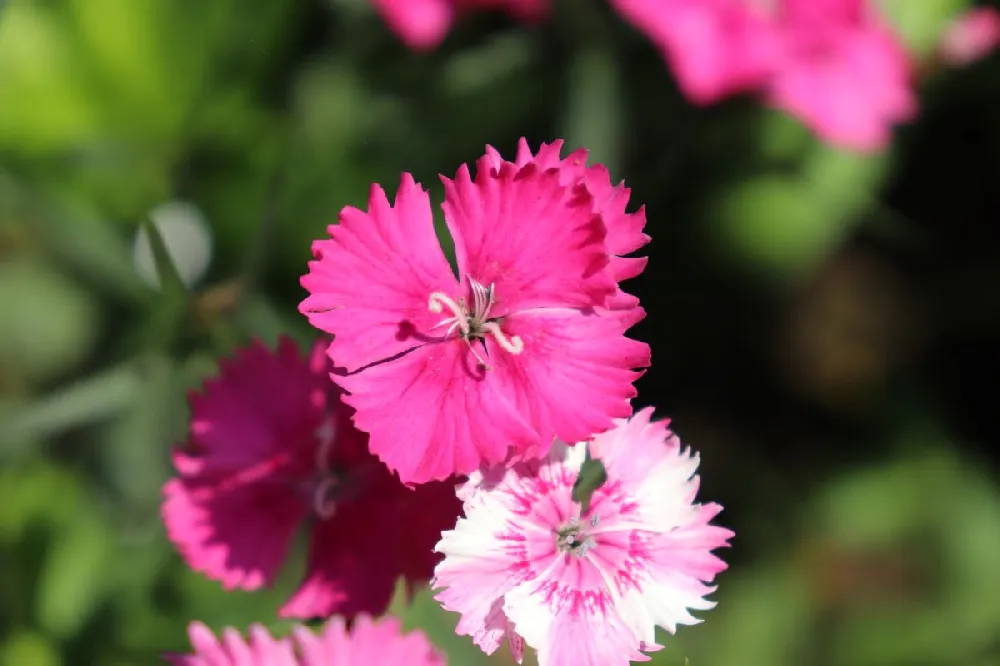- Home >
- Dianthus Flowers
Dianthus Flowers for Sale - Buying & Growing Guide
5 Results
Planting and Care
Planting instructions
Plant dianthus flowers outdoors after the last frost of the season. These plants tend to struggle in acidic soil, so check your soil’s pH to ensure that it is neutral or alkaline before planting. Choose a location where the plants will receive at least six hours of sunlight daily. Dianthus flowers tend to spread out, so leave 12-18 inches between plants. Dianthus flowers also need to be planted in well-draining soil so they don’t succumb to root rot. You can grow dianthus plants in most climates that do not experience extreme temperatures (consistently below 40 degrees Fahrenheit or above 85 degrees Fahrenheit).
Watering and nutrients
Watering dianthus plants is primarily about striking a balance. They are thirsty plants and do not like their soil to dry out, as this can inhibit flower production. However, they are susceptible to root rot and stem rot if their soil becomes waterlogged. In most cases, a thorough watering once per week is sufficient to keep the soil moist but not soggy, especially if you’ve planted your dianthuses in well-draining soil. You can apply a regular fertilizer every six to eight weeks during the growing season, or use a slow-release fertilizer when planting your dianthus flowers.
Pollination
If you like butterflies and want to attract more of them to your garden, dianthus flowers are a good choice as these plants rely on butterflies for pollination. Butterflies are attracted to the sweet nectar and colorful blossoms produced by these flowers, and help transfer pollen between plants as they eat. To encourage these pollinators in your garden, avoid using herbicides and pesticides, plant a variety of sweet-smelling flowers, and provide water and shade for butterflies.
Pruning
Pruning your dianthus flowers after they bloom in the spring can encourage reblooming in the fall. Remove spent flowers as they wilt (a process known as deadheading), and trim the plant back to about half its size. Not only will this foster more bloom production, it will also create a fuller, bushier shape. You should also trim off any dead or damaged stems throughout the growing season. In the fall, when your dianthus begins to die back, prune the whole plant back to almost ground level, leaving just a few inches of stems, to help preserve the plant’s energy.
Pests, diseases, and animals
While dianthus flowers are deer resistant, they are popular with rabbits. These flowers also attract some common garden pests like carnation flies, spider mites, and aphids. To combat carnation fly infestations, spray the plant with garlic tea, or plant garlic nearby. For spider mite and aphid problems, treat your plants with insecticidal soap, or spray them with a strong blast of water. These plants are also susceptible to fungal diseases like powdery mildew, downy mildew, and botrytis, which are caused by too much moisture on the petals and poor air circulation around plants.
Light
Like many flowering plants, the dianthus loves the sun. Ensure you position it in a spot that gets at least six hours of full sun a day, to enable it to produce the blooms it is famed for. It can tolerate some shade, but too much shade will cause it to struggle with flower production, and the plant can become leggy in an attempt to reach towards the light. If full sun is not possible, choose a position that offers a few hours of shade in the afternoon. This will ensure the plant gets plenty of morning sun, and will also protect it from becoming too hot in the strong afternoon heat.
Temperature
One of the reasons this plant has remained so popular for such a long time is its ability to withstand a wide range of temperatures. It can be grown in most climates that do not experience extreme temperatures. Unlike many flowering plants, the dianthus will even withstand light frosts, but temperatures below 40° F cannot be tolerated, and deep freezes will see the plant die down to the ground. Hot temperatures can also cause problems for this plant, and highs of 85° F and over should be avoided. Very hot temperatures such as this can cause the plant to enter a period of dormancy to protect itself.
Humidity
Dianthus plants do not like high humidity and grow well in average air conditions.
Propagation
Dianthus plants are easy to propagate from stem cuttings, and this is an inexpensive way to replace older plants that are coming to the end of their lifespan. Propagation works best in spring or summer when plant cells are dividing quickly, so rooting happens more easily. Take several cuttings from healthy fresh stems that have not yet flowered.
You will need a length of stem with around five sets of leaves on it, cutting it from the main plant just below a node where a set of leaves join the stem. Remove all of the lower sets of leaves from your stems, and prepare a container of moist potting soil to root the stems in. Ensure the potting soil is moist, and make several holes in the soil with a pencil. Dip the raw end of the stems in rooting hormone, and then insert them into the premade holes.
They should be spaced apart enough so that the leaves are not touching, and inserted deep enough so that only half of the stem is left poking out from the soil. Cover the stems and container with a plastic bag to create a humid environment and set it in a bright spot away from direct sunlight, such as a windowsill. Maintain moist soil and wait for the stems to root. Once new growth occurs on the visible parts of the stem, this is an indication that roots present and getting stronger, and they can be transplanted to a more permanent home in a larger container or directly into the ground (Gardeners World Magazine).
Flowering
Dianthus plants typically flower from early spring right through to fall. The flowers are available in a range of colors, including pink, red, white, and purple, though most varieties feature some shade of pink, which is how they became commonly known as ‘pinks.’ The flowers each have five petals and typically have serrated edges. They are enormously popular in home gardens because the flowers are so easy to grow and care for and offer a bright and cheerful aesthetic. These flowers also make excellent cut flowers and are renowned for their long-lasting quality.
Dianthus Flower Varieties
There are over 300 varieties of dianthus, encompassing perennials, annuals, and biennials. They grow to various heights, with some having a low growing nature that is suitable for use as ground spread, while others have a mounding habit.
Chinese Pink (Dianthus chinensis)
This perennial dianthus plant is hugely popular. It is heavily adorned with flowers that are often bicolor with a dark center. It can grow to heights of anywhere from a petite 6 inches up to 30 inches. It enjoys full sun but thrives in cooler temperatures, and in hot climates will need some shaded protection from afternoon sun.
Sweet William (Dianthus barbatus)
This short-lived perennial or biennial is native to southern Europe. Its flowers bloom in clusters on erect stems which can measure up to 24 inches tall, lasting from around May to October.
Cheddar Pink (Dianthus gratianopolitanus)
This evergreen perennial has seen a wave of popularity since receiving the Award of Garden Merit from the Royal Horticultural Society. The small flowers are heavily scented and are attractive to butterflies and hummingbirds, but the plant is resistant to deer. The foliage of this variety is grass-like, and work well as ground cover, border edging, and in flower beds or containers.
FAQs
What are the most popular dianthus flower species?
Dianthus is a genus of roughly 300 species of flowering plants that belong to the family Caryophyllales. Some of the most popular species are sweet William, which often feature bicolor combinations with a contrasting eye and fringed petals; cheddar pink, which grows low to the ground on grass-like stems and has rose or dark pink petals; and carnations, which are available in a wide variety of colors, thanks to thousands of years of cultivating.
Are dianthus flowers annual or perennial?
It depends on the particular species. The majority of dianthus flowers are perennials, but this genus does contain some annual and biennial species as well. Sweet William is perhaps the best-known biennial species of dianthus flowers, while Chinese pink is a popular annual variety. Common perennial species of dianthus flowers include carnation, cheddar pink, and North Cyprus pink. Check the species carefully before purchasing a dianthus species to ensure it will grow as desired.
Are dianthus flowers poisonous?
Dianthus flowers are mildly toxic to humans and common household pets like dogs and cats, although in different ways. The leaves of dianthus plants contain triterpenoid saponins in their leaves, which can cause minor skin irritation, or upset stomach if ingested. The leaves of the plant will also cause mild gastrointestinal distress in cats and dogs if consumed, and can irritate an animal’s skin.
How do you propagate dianthus flowers?
The easiest way to propagate a dianthus plant is through stem cuttings in the spring or summer. Cut a length of stem with approximately five sets of leaves just below a node. Dip the stems in rooting hormone, and place them in small holes in moist potting soil. Cover the stems with a plastic bag, creating a humid environment, and set the pot where it will receive bright, indirect sunlight. Once new growth occurs, you can transfer your plants to a more permanent home.








